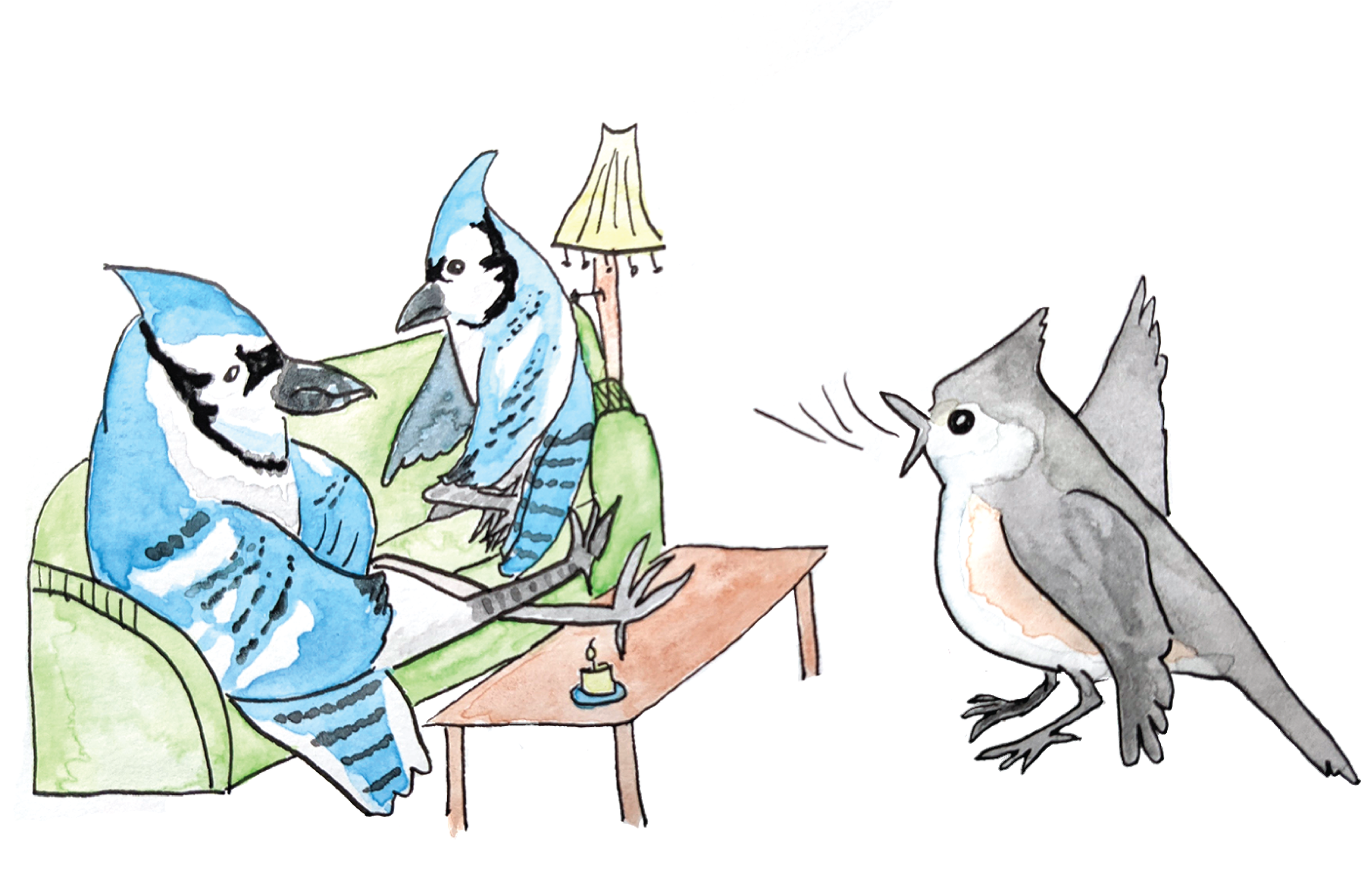Tufted Titmouse
Hooray! The tufted titmouse is here to give us a chance to practice the identification skills we picked up earlier in the guide. Like with many birds, the easiest way to identify titmouse vocalizations is by comparing them to other birds. The titmouse conveniently sounds like a cross between a black-capped chickadee and a blue jay on drugs (no surprise there, blue jay).
The Titmouse and the Babysitter’s BF
The tufted titmouse, although unfortunately named, thinks he’s a cool guy. Still, nobody could be as cool as his babysitter’s boyfriend. Little Tufted Tit reminds the couple they are there most exclusively to watch his cousin, Chickadee, who is already tucked into bed like a little baby. Tufted titmouse insists he gets to stay up late. To sound impressive, he imitates the cool babysitter’s boyfriend, Blue Jay. Remember, Jay often shrieks,
“Jay! Jay! Jay!”
Tufted Titmouse gives this a try. He calls out his own name— sort of. Tufted Titmouse rightly hates his given name, and insists others call him Peter.
“Peter! Peter! Peter!”
He calls in a voice that sounds similar to the jay’s clownish cop whistle impression. Titmouse is trying for anything but clownish. He takes himself most seriously.
Jay shows no interest, only mild irritation. Titmouse wants to stay up late with the big kids. He tries another tac. He knows about jay’s little hobby. He announces this knowledge to the world, hoping jay will be impressed,
“Weeder! Weeder! Weeder!”
That’s the 6th grader word for what the upper levels are doing when they skip class at Tufted Titmouse Academy. Neither the babysitter nor her boyfriend are impressed. Titmouse tries again— acts like the others are missing the joke,
“Neener! Neener! Neener!”
He won’t quit. He sings out his poor imitation of the blue jay’s whistle even after the babysitter threatens she’ll tell Grandma EVERYTHING.
A Brief Anecdote on Chickadee’s Rivalry with Cousin Titmouse (and Grandma’s Bias)
By day, Tufted Titmouse really does feel like a cool guy. He can tell his cousin, the black-capped chickadee, envies him for his size, his crest, his golden fringed vest, his big city accent. Chickadee does envy him, but takes solace in the knowledge that no one will ever grace Grandma’s walls like he does. Titmouse may be cool, but chickadee is beloved.
Despite the Name, Let’s Get Serious
The tufted titmouse is in fact cousin to the chickadee. Chickadees and titmice reside in the family Paridae. The titmouse is larger and more aggressive than the chickadee, but the cousins can be found foraging in the same flocks. They share many physical and behavioral traits, but the titmouse is larger and often more aggressive.
If you hear something that sounds like it could be a chickadee’s cousin with a big city accent, check it out. Titmice often repeat the “dee-dee-dee” part that’s familiar from the chickadee call. When they say it, it’s buzzier, messier, and often louder.
During breeding season, if you hear that call interspersed with a song that sounds like a chemically impared jay doing its traffic cop clownish whistle, you may be on the trail of a titmouse.
The titmouse insistently repeats its two syllable song. Like chickadees, titmice remain relatively (relatively!— everyone has boundaries that should be honored!) unperturbed by the presence of people, meaning if you are respectful about it, you can poke around and track them down without scaring them away. Like chickadees, they’re cavity nesters that travel in mixed winter flocks. If you’re catching sight of a titmouse in winter, keep your eyes and ears peeled for chickadees, nuthatches, and woodpeckers. If you are hearing a lot from them in spring, keep on the lookout for promising nesting cavities. What could be more adorable than a baby titmouse?
Around southern Wisconsin anyhow, titmice are less common than chickadees. With their fancy crest and sleek plummage (that is just the absolute most fun and perfect color to paint with watercolor), they are a true gem of a bird. Catching a glimpse of one of these guys is always a treat.
Titmouse song sounds a lot like the jay’s whistle but always made of two notes repeated.
Titmouse call demonstrates their relation to chickadees with the repeated “Dee-dee-dee.”

